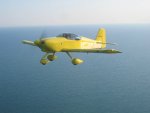Правильно построенный и правильно нагруженный LongEze как и другие ему подобные аппараты войдет в штопор как миленький. Для этого действительно нужно будет потрудиться. Но исключать такую вероятность нельзя. Точно также из состояния установившейся авторотации его практически невозможно будет вывести. А это уже хуже. В летном эксперименте, который проводили Рутан сотоварищи (см. Canard Pusher CP55 выше), вывели чудом. Там сказано, что особенно следует опасаться такой ситуации, если самолет имеет отклонения в геометрии, центровке и нивелировке, но, как я уже отмечал, это не вся Одесса.
Если самолет сильно сопротивляется вводу в штопор, то есть серьезные предпосылки, что он так же с трудом будет выходить из него. Физическое объяснение этому явлению имеется. Уткина схема к этому добавляет свои неприятности.
У самолета любой схемы может быть область скрытой авторотации.
Есть такая кривая ротационного момента. Это зависимость вращающего момента по крену от угловаой скорости этого вращения. Она, в свою очередь, изменяет свою форму в зависимости от центровки, режима работы двигателя, положения рулей и механизации и при скольжении. Короче говоря, она зависит от всего, что может измениться.
Когда самолет устойчив к штопору, эта кривая вся лежит в отрицательной полуплоскости. То есть, если мы завращаем наш самолте внешним моментом, это вращение затухнет. такое поведение будет иметь место, в частности, при докритическом обтекании всех сечений крыла.
Если же один из концов крыла, например, будет в срыве, то эта кривая сперва пойдет вверх, следовательно, самолет, получив сколь угодно малое вращение, будет раскручиваться дальше сам. Затем кривая достигнет максимума и вновь персечет ось абсцисс в неткоторой точке. Это будет угловая скорость вращения по крену в установившемся штопоре. эта точка будет лазить туда-сюда по оси абсцисс (угловых скоростей крена) в зависимости от чего углодно, в первую очередь от угла атаки в момент ввода в штопор и центровки.
Если при этом качественно вид кривой не изменяется по отношению к вышеописанному, то это нормальная ситуация. В таком случае параметры штопорного вращения устанавливаются быстро.
Но возможно, что кривая ротационного момента сначала идет в отрицательной области, а затем отклоняется вверх и высовывается в положительную полуплоскость, потом она вновь пересекает ось абсцисс. Между этими двумя точками и лежит область скрытой авторотации. Попасть туда самолет может при энергичных пространственных маневрах, в условиях атмосферной турбулентности и многих других ситуациях, которые сразу все невозможно предвидеть. Также эта область перемещается по оси угловых скоростей вращения в зависимости от кучи параметров, может исчезать, появляться вновь в другом месте и пр.
Самолеты со стреловидным крылом, большими винглетами и значительной поверхностью тела, находящейся впереди крыла ми большим разносом сосредоточенных масс имеют эту пакость совершенно обязательно. Теоренически у рутановской утки она может исчезнуть при таких передних центровках, когда никакого ПГО не хватит для балансировки.
Для того, чтобы гарантированно не получить концевой срыв на одной из консолей крыла при всевозможных эволюциях самолета, недостоточно того запаса угла атаки, который создается засчет опрежающего срыва на ПГО. Этот запас 2-3градуса, а нужно, возможно более 10. Ситуация усугубляется стреловидностью и стрейками.
Накладки с запилом на носках концевых отсеков крыла а-ля Ил-62, по данным испытаний NACA позволили сохранить безотрывное обтекание на прямом крыле умеренного удлинения до углов атаки свыше 30 градусов. Это получилось получше , чем концевой предкрылок, в то же время практически без прироста профильного сопротивления.
Однако, такая модификация крыла даже на нормальном самолете может дать область скрытой авторотации.
Все такие меры следует поэтому использовать осторожно.
Ограничение угла атки при полностью взятой на себя ручке и совершенно такое же поведение самолета на больших углах атаки, как у Рутана, совершенно элементарно получается на самолете нормальной балансировочной схемы. Можно получить еще более интересные результаты.
В отличие от утки, нормално расположенное ГО классического самолета при этом будет находится в докритическом диапазоне углов атаки и поэтому самолет сохранит и динамическую продольную устойчивость.
Требуемый запас по углу атаки для безопаного маневрирования самолета любой схемы может быть гарантирован только при определенном запасае скорости до сваливания. Разные самолеты, однако, позволяют обеспечить это запас скорости тоже по - разному.

